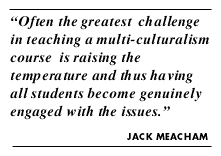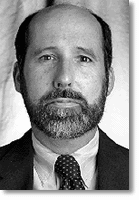
Multicultural Dialogue: Discussion in class helps students in 'real
world'
By SUE WUETCHER
News Services Associate Director
 Engaging students in classroom dialogue about multicultural issues that
respects the integrity of others' views, prepares them for the debate
about these important-and often controversial-issues that goes on as
part of a larger, democratic society, a UB psychologist says.
Engaging students in classroom dialogue about multicultural issues that
respects the integrity of others' views, prepares them for the debate
about these important-and often controversial-issues that goes on as
part of a larger, democratic society, a UB psychologist says.
Jack Meacham, professor of psychology, says the key to
maintaining a meaningful discussion is for faculty members to
"anticipate when students might become defensive, angry or hurt, or when
conflict might erupt." This, he notes, will help instructors "know when
to lower the temperature (in the classroom), as well as when to raise
the temperature."
Meacham, who conducts workshops on multicultural education for
colleges and universities, has published articles on the topic in
journals such as Liberal Education and was guest editor of the
November/December American Behavioral Scientist, which was a special
issue on "Multiculturalism and Diversity in Higher Education." At UB, he
teaches a general-education course entitled "American Pluralism" and
covers such topics as religion in a developmental psychology course.
Meacham says the issues that arise in a
multiculturalism course "can touch students very personally, for gender,
religion, ethnicity, sexual orientation and race are among the core
dimensions of the identities that traditional college-aged students and
young adults are constructing."
 Moreover, for many students-whose ideas about themselves and society
in general are grounded in their limited experience of growing up in
homogeneous neighborhoods-a multiculturalism course provides the first
opportunity to talk about these issues with persons who are unlike
themselves.
Moreover, for many students-whose ideas about themselves and society
in general are grounded in their limited experience of growing up in
homogeneous neighborhoods-a multiculturalism course provides the first
opportunity to talk about these issues with persons who are unlike
themselves.
The experience can be difficult, he admits, noting that viewpoints
can be seriously challenged and emotional conflicts can arise, since
students do not leave their feelings or personal experiences at the door
when they enter a classroom for a multicultural course.
Meacham offers several tips for maintaining meaningful debate on
multicultural topics in the classroom without unnecessary conflict:
· Stay in close touch with what students are
thinking-but not saying-aloud. End the discussion a few minutes early
and ask students to write a few anonymous paragraphs that summarize the
issue's pros and cons, or that suggest how the discussion could be
improved.
· Raise only issues that can be resolved, in some sense,
during a class period or over the course of a term. The introduction of
more difficult and challenging issues may require more planning on the
part of the faculty member from day to day throughout the course than is
the case in other courses.
· Frame difficult issues in terms of empowerment, rather
than victimization. "Rather than framing the course so that students
conclude that misunderstandings and animosities are part of the human
condition and always will be, it is far better to challenge them to
consider what actions they might take in their own lives to reduce
prejudice and discrimination on campus, in their communities and
nationally."
· At the beginning of the term, discuss with the entire
class the potential for classroom conflict and establish some informal
procedures for avoiding conflict. For example, let two or three other
students speak before a very talkative student speaks again. "It is, of
course, not any particular procedures that are important, but rather
engaging in such discussions so that students become aware of their
shared responsibility for developing a classroom atmosphere in which
they can freely express their own viewpoints without fear of being
attacked."
· Have ready a set of procedures for shifting the class
away from awkward or conflict-laden situations. These may include the
careful use of humor, redirecting the emotional energy of the discussion
from talking to writing or early dismissal of the class.
Meacham points out that discussion in a multicultural class-as in any
class-can be dull and not conducive to good learning. Students may not
speak out due to fear of saying something wrong; fear of exposing, and
having to examine, their own assumptions, or difficulty in reconciling
what they are learning with prior beliefs and values, he says.
"Often the greatest challenge in teaching a multiculturalism course
is raising the temperature and thus having all students become genuinely
engaged with the issues," he says.
He suggests framing an issue in terms of sharply contrasting
positions, such as pointing to simplistic media portrayals, as a means
of gaining students' interest. Also, permitting emotions to enter into
the discussion can be a means of raising issues or topics that students
wouldn't otherwise talk about.
The multiculturalism classroom, Meacham says, provides students
"with opportunities to engage in the skills and practices of dialogue
and debate that they must have as citizens if our democratic and
multicultural society is to endure."
![[Current Issue]](http://www.buffalo.edu/reporter/icons/Goto_Current.gif)
![[
Table of Contents ]](http://www.buffalo.edu/reporter/icons/TOC.gif)
![[
Search Reporter ]]( http://www.buffalo.edu/reporter/icons/Newspaper.gif)
![[Talk to
Reporter]](
http://www.buffalo.edu/reporter/icons/Phone.gif)
 Moreover, for many students-whose ideas about themselves and society
in general are grounded in their limited experience of growing up in
homogeneous neighborhoods-a multiculturalism course provides the first
opportunity to talk about these issues with persons who are unlike
themselves.
Moreover, for many students-whose ideas about themselves and society
in general are grounded in their limited experience of growing up in
homogeneous neighborhoods-a multiculturalism course provides the first
opportunity to talk about these issues with persons who are unlike
themselves. 
 Engaging students in classroom dialogue about multicultural issues that
respects the integrity of others' views, prepares them for the debate
about these important-and often controversial-issues that goes on as
part of a larger, democratic society, a UB psychologist says.
Engaging students in classroom dialogue about multicultural issues that
respects the integrity of others' views, prepares them for the debate
about these important-and often controversial-issues that goes on as
part of a larger, democratic society, a UB psychologist says.